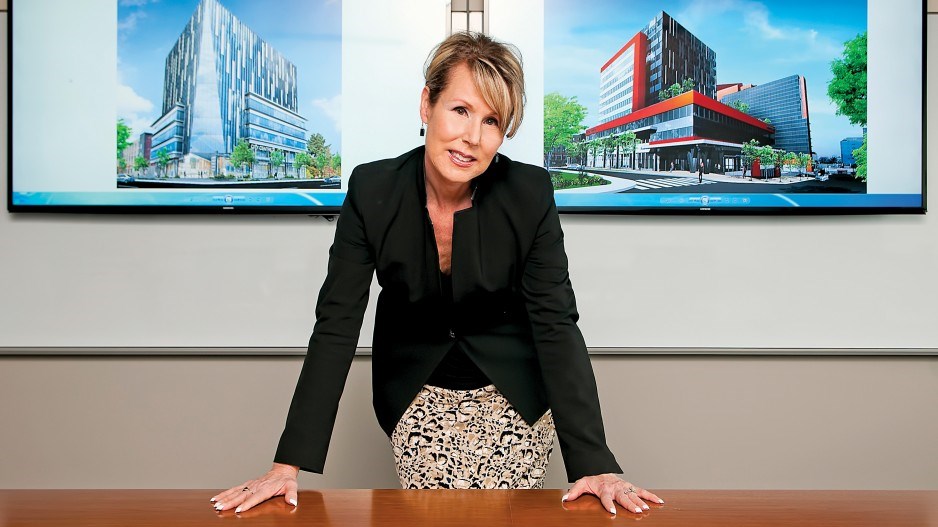The Surrey Health and Technology District will inject $1.1 billion annually into the local economy once construction is completed in less than a decade, its backers say.
Spearheaded by the Lark Group, the eight-building, $625 million project, which will be a part of the larger Innovation Boulevard, recently broke ground on its second building, City Centre 2. Rowena Rizzotti, the Lark Group's vice-president of health care and innovation, said the project will create an estimated 5,340 direct and 8,010 indirect jobs, which would work out to roughly $1 billion in annual salaries.
Rizzotti said the aim of the district is to “create an ecosystem for clinicians and health-care providers to work alongside innovators and entrepreneurs, tech companies, startup tech companies and large multinational tech companies” adjacent to Surrey Memorial, one of Canada’s busiest hospitals.
City Centre 1, completed in 2014, is the workplace of about 90 medical professionals. Construction on City Centre 3 is expected to start this year. Rizzotti and some of the initial partners for Surrey’s Innovation Boulevard travelled the world visiting tech and health hubs in areas such as Boston and Silicon Valley seeking ideas for Surrey’s plan.
But Rizzotti said the medical profession is facing a unique technological challenge: difficulty in harnessing new technologies for health-care uses.
While self-driving cars, artificial intelligence and virtual reality are all breaking into the marketplace, Rizzotti said health care is still inherently archaic.
“All this has not been able to translate a lot yet into health-care system improvements. We’ve still got a very conventional system, so the intent of [the Health and Technology District] is to attract some of the existing technologies and the existing devices and solutions that have been embedded and implemented into other systems and attract them to this.”
Former Surrey mayor Dianne Watts, former chief executive officer for the Health Tech Innovation Foundation, said the idea is to give tech entrepreneurs avenues to test their products and, eventually, commercialize them.
“The technology out there in many hubs across the country is struggling to get their products to market,” Watts said. “So for us, that is the one piece we focused on: to ensure companies could test their products, make sure they could go through all of the regulations to get to commercialization.”
Innovation Boulevard has already partnered with some private companies, including Conquer Mobile, which makes virtual-reality simulations for medical education, and MetaOptima, the makers of a smartphone attachment for skin cancer screening.
Victor Davis, key account executive for B.C. at Philips Healthcare, which has set up shop at City Centre 1, said in an email that the health-tech hub has “afforded the Philips team tremendous opportunities for networking, market research and to engage in ongoing highly productive discussions across the entire spectrum of a dynamic health-care landscape with technology providers, researchers, top clinicians, academics and policy-makers.”
Recent studies estimate that about 40% of Surrey’s population lives and works within the city, rather than commuting to other Lower Mainland municipalities. Rizzotti said for this planned district to thrive, it needs to fill job openings with young Surrey residents.
“A third of [Surrey’s] population is youth, so that’s the workforce of the future, and we need to accommodate them so they don’t need to go elsewhere to get jobs.”
Rizzotti said Surrey has two things going for it that many health and/or tech hubs don’t usually have: lots of developable land and an influx of immigrants with specialized skills.
“That allows for us to then attract and retain high-tech talent that now has to often go out of the country for those types of jobs, to places like Silicon Valley and otherwise. So I think the economic impact is really important. We want those companies, globally, to be attracted to Canada to come and set up shop here.”
Elizabeth Model, executive director of the Downtown Surrey Business Improvement Association, said this all has to start with getting the word out to the local community first.
“If Lark is looking to allow Surreyites first opportunity for the jobs created in health tech, it would be a fabulous opportunity to partner with [Simon Fraser University] Surrey or [Kwantlen Polytechnic University] Surrey for a hiring career fair and allow collaboration between the universities and local businesses. As long as the new immigrants meet the Canadian standards and match the skill sets required, everyone should be allowed fair and equal opportunities for employment.”
– With files from Tyler Orton




